3.E: Practice
( \newcommand{\kernel}{\mathrm{null}\,}\)
Electric Potential Practice
Conceptual Questions
Electric Potential Energy
1. Would electric potential energy be meaningful if the electric field were not conservative?
2. Why do we need to be careful about work done on the system versus work done by the system in calculations?
3. Does the order in which we assemble a system of point charges affect the total work done?
Electric Potential and Potential Difference
4. Discuss how potential difference and electric field strength are related. Give an example.
5. What is the strength of the electric field in a region where the electric potential is constant?
6. If a proton is released from rest in an electric field, will it move in the direction of increasing or decreasing potential? Also answer this question for an electron and a neutron. Explain why.
7. Voltage is the common word for potential difference. Which term is more descriptive, voltage or potential difference?
8. If the voltage between two points is zero, can a test charge be moved between them with zero net work being done? Can this necessarily be done without exerting a force? Explain.
9. What is the relationship between voltage and energy? More precisely, what is the relationship between potential difference and electric potential energy?
10. Voltages are always measured between two points. Why?
11. How are units of volts and electron-volts related? How do they differ?
12. Can a particle move in a direction of increasing electric potential, yet have its electric potential energy decrease? Explain
Calculations of Electric Potential
13. Compare the electric dipole moments of charges ±Q separated by a distance d and charges ±Q/2 separated by a distance d/2.
14. Would Gauss’s law be helpful for determining the electric field of a dipole? Why?
15. In what region of space is the potential due to a uniformly charged sphere the same as that of a point charge? In what region does it differ from that of a point charge?
16. Can the potential of a nonuniformly charged sphere be the same as that of a point charge? Explain.
Determining Field from Potential
17. If the electric field is zero throughout a region, must the electric potential also be zero in that region?
18. Explain why knowledge of →E(x,y,z) is not sufficient to determine V(x,y,z). What about the other way around?
Equipotential Surfaces and Conductors
19. If two points are at the same potential, are there any electric field lines connecting them?
20. Suppose you have a map of equipotential surfaces spaced 1.0 V apart. What do the distances between the surfaces in a particular region tell you about the strength of the →E in that region?
21. Is the electric potential necessarily constant over the surface of a conductor?
22. Under electrostatic conditions, the excess charge on a conductor resides on its surface. Does this mean that all of the conduction electrons in a conductor are on the surface?
23. Can a positively charged conductor be at a negative potential? Explain.
24. Can equipotential surfaces intersect?
Applications of Electrostatics
25. Why are the metal support rods for satellite network dishes generally grounded?
26. (a) Why are fish reasonably safe in an electrical storm?
(b) Why are swimmers nonetheless ordered to get out of the water in the same circumstance?
27. What are the similarities and differences between the processes in a photocopier and an electrostatic precipitator?
28. About what magnitude of potential is used to charge the drum of a photocopy machine? A web search for “xerography” may be of use.
Problems
Electric Potential Energy
29. Consider a charge Q1(+5.0μC) fixed at a site with another charge Q2 (charge +3.0μC, mass 6.0μg) moving in the neighboring space. (a) Evaluate the potential energy of Q2 when it is 4.0 cm from Q1. (b) If Q2 starts from rest from a point 4.0 cm from Q1, what will be its speed when it is 8.0 cm from Q1? (Note: Q1 is held fixed in its place.)
30. Two charges Q1(+2.00μC) and Q2(+2.00μC) are placed symmetrically along the x-axis at x=±3.00cm. Consider a charge Q3 of charge +4.00μC and mass 10.0 mg moving along the y-axis. If Q3 starts from rest at y=2.00cm, what is its speed when it reaches y=4.00cm?
31. To form a hydrogen atom, a proton is fixed at a point and an electron is brought from far away to a distance of 0.529×10−10m, the average distance between proton and electron in a hydrogen atom. How much work is done?
32. (a) What is the average power output of a heart defibrillator that dissipates 400 J of energy in 10.0 ms? (b) Considering the high-power output, why doesn’t the defibrillator produce serious burns?
Electric Potential and Potential Difference
33. Find the ratio of speeds of an electron and a negative hydrogen ion (one having an extra electron) accelerated through the same voltage, assuming non-relativistic final speeds. Take the mass of the hydrogen ion to be 1.67×10−27kg.
34. An evacuated tube uses an accelerating voltage of 40 kV to accelerate electrons to hit a copper plate and produce X-rays. Non-relativistically, what would be the maximum speed of these electrons?
35. Show that units of V/m and N/C for electric field strength are indeed equivalent.
36. What is the strength of the electric field between two parallel conducting plates separated by 1.00 cm and having a potential difference (voltage) between them of 1.50×104V?
37. The electric field strength between two parallel conducting plates separated by 4.00 cm is 7.50×104V.
(a) What is the potential difference between the plates?
(b) The plate with the lowest potential is taken to be zero volts. What is the potential 1.00 cm from that plate and 3.00 cm from the other?
38. The voltage across a membrane forming a cell wall is 80.0 mV and the membrane is 9.00 nm thick. What is the electric field strength? (The value is surprisingly large, but correct.) You may assume a uniform electric field.
39. Two parallel conducting plates are separated by 10.0 cm, and one of them is taken to be at zero volts.
(a) What is the electric field strength between them, if the potential 8.00 cm from the zero volt plate (and 2.00 cm from the other) is 450 V?
(b) What is the voltage between the plates?
40. Find the maximum potential difference between two parallel conducting plates separated by 0.500 cm of air, given the maximum sustainable electric field strength in air to be 3.0×106V/m.
41. An electron is to be accelerated in a uniform electric field having a strength of 2.00×106V/m.
(a) What energy in keV is given to the electron if it is accelerated through 0.400 m?
(b) Over what distance would it have to be accelerated to increase its energy by 50.0 GeV?
42. Use the definition of potential difference in terms of electric field to deduce the formula for potential difference between r=ra and r=rb for a point charge located at the origin. Here r is the spherical radial coordinate.
43. The electric field in a region is pointed away from the z-axis and the magnitude depends upon the distance s from the axis. The magnitude of the electric field is given as E=αs where α is a constant. Find the potential difference between points P1 and P2, explicitly stating the path over which you conduct the integration for the line integral.
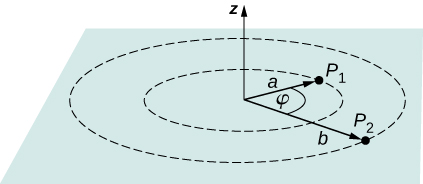
44. Singly charged gas ions are accelerated from rest through a voltage of 13.0 V. At what temperature will the average kinetic energy of gas molecules be the same as that given these ions?
Calculations of Electric Potential
45. A 0.500-cm-diameter plastic sphere, used in a static electricity demonstration, has a uniformly distributed 40.0-pC charge on its surface. What is the potential near its surface?
46. How far from a 1.00−μC point charge is the potential 100 V? At what distance is it 2.00×102V?
47. If the potential due to a point charge is 5.00×102V at a distance of 15.0 m, what are the sign and magnitude of the charge?
48. In nuclear fission, a nucleus splits roughly in half. (a) What is the potential 2.00×10−14m from a fragment that has 46 protons in it? (b) What is the potential energy in MeV of a similarly charged fragment at this distance?
49. A research Van de Graaff generator has a 2.00-m-diameter metal sphere with a charge of 5.00 mC on it. Assume the potential energy is zero at a reference point infinitely far away from the Van de Graaff.
(a) What is the potential near its surface?
(b) At what distance from its center is the potential 1.00 MV?
(c) An oxygen atom with three missing electrons is released near the Van de Graaff generator. What is its kinetic energy in MeV when the atom is at the distance found in part b?
50. An electrostatic paint sprayer has a 0.200-m-diameter metal sphere at a potential of 25.0 kV that repels paint droplets onto a grounded object.
(a) What charge is on the sphere?
(b) What charge must a 0.100-mg drop of paint have to arrive at the object with a speed of 10.0 m/s?
51. (a) What is the potential between two points situated 10 cm and 20 cm from a 3.0−μC point charge?
(b) To what location should the point at 20 cm be moved to increase this potential difference by a factor of two?
52. Find the potential at points P1,P2,P3, and P4 in the diagram due to the two given charges.
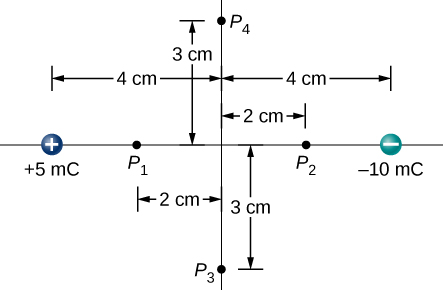
53. Two charges –2.0µC and +2.0µC are separated by 4.0 cm on the z-axis symmetrically about origin, with the positive one uppermost. Two space points of interest P1 and P2 are located 3.0 cm and 30 cm from origin at an angle 30° with respect to the z-axis. Evaluate electric potentials at P1 and P2 in two ways:
(a) Using the exact formula for point charges, and
(b) using the approximate dipole potential formula.
54. (a) Plot the potential of a uniformly charged 1-m rod with 1 C/m charge as a function of the perpendicular distance from the center. Draw your graph from s=0.1m to s=1.0m.
(b) On the same graph, plot the potential of a point charge with a 1-C charge at the origin.
(c) Which potential is stronger near the rod? (d) What happens to the difference as the distance increases? Interpret your result.
Determining Field from Potential
55. Throughout a region, equipotential surfaces are given by z=constant. The surfaces are equally spaced with V=100V for z=0.00m,V=200V for z=0.50m,V=300V for z=1.00m. What is the electric field in this region?
56. In a particular region, the electric potential is given by V=−xy2z+4xy. What is the electric field in this region?
57. Calculate the electric field of an infinite line charge, throughout space.
Equipotential Surfaces and Conductors
58. Two very large metal plates are placed 2.0 cm apart, with a potential difference of 12 V between them. Consider one plate to be at 12 V, and the other at 0 V. (a) Sketch the equipotential surfaces for 0, 4, 8, and 12 V.
(b) Next sketch in some electric field lines, and confirm that they are perpendicular to the equipotential lines.
59. A very large sheet of insulating material has had an excess of electrons placed on it to a surface charge density of –3.00nC/m2.
(a) As the distance from the sheet increases, does the potential increase or decrease? Can you explain why without any calculations? Does the location of your reference point matter?
(b) What is the shape of the equipotential surfaces?
(c) What is the spacing between surfaces that differ by 1.00 V?
60. A metallic sphere of radius 2.0 cm is charged with +5.0−μC charge, which spreads on the surface of the sphere uniformly. The metallic sphere stands on an insulated stand and is surrounded by a larger metallic spherical shell, of inner radius 5.0 cm and outer radius 6.0 cm. Now, a charge of −5.0−μC is placed on the inside of the spherical shell, which spreads out uniformly on the inside surface of the shell. If potential is zero at infinity, what is the potential of
(a) the spherical shell,
(b) the sphere,
(c) the space between the two,
(d) inside the sphere, and
(e) outside the shell?
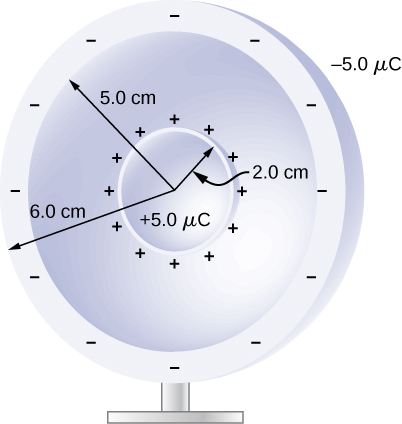
61. Two large charged plates of charge density ±30μC/m2 face each other at a separation of 5.0 mm.
(a) Find the electric potential everywhere.
(b) An electron is released from rest at the negative plate; with what speed will it strike the positive plate?
62. A long cylinder of aluminum of radius R meters is charged so that it has a uniform charge per unit length on its surface of λ.
(a) Find the electric field inside and outside the cylinder.
(b) Find the electric potential inside and outside the cylinder. (c) Plot electric field and electric potential as a function of distance from the center of the rod.
63. Two parallel plates 10 cm on a side are given equal and opposite charges of magnitude 5.0×10−9C.The plates are 1.5 mm apart. What is the potential difference between the plates?
64. The surface charge density on a long straight metallic pipe is σ. What is the electric potential outside and inside the pipe? Assume the pipe has a diameter of 2a.

65. Concentric conducting spherical shells carry charges Q and –Q, respectively. The inner shell has negligible thickness. What is the potential difference between the shells?
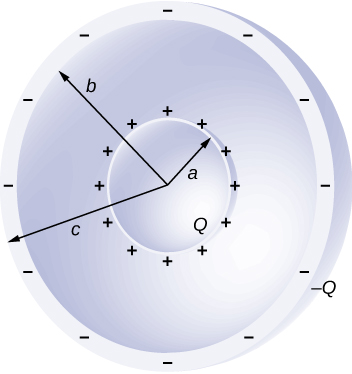
66. Shown below are two concentric spherical shells of negligible thicknesses and radii R1 and R2. The inner and outer shell carry net charges q1 and q2, respectively, where both q1 and q2 are positive. What is the electric potential in the regions (a) r<R1, (b) R1<r<R2, and (c) r>R2?
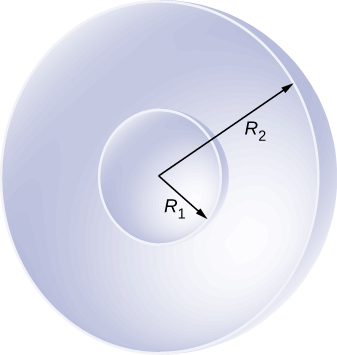
67. A solid cylindrical conductor of radius a is surrounded by a concentric cylindrical shell of inner radius b. The solid cylinder and the shell carry charges Q and –Q, respectively. Assuming that the length L of both conductors is much greater than a or b, what is the potential difference between the two conductors?
Applications of Electrostatics
68. (a) What is the electric field 5.00 m from the center of the terminal of a Van de Graaff with a 3.00-mC charge, noting that the field is equivalent to that of a point charge at the center of the terminal?
(b) At this distance, what force does the field exert on a 2.00−μC charge on the Van de Graaff’s belt?
69. (a) What is the direction and magnitude of an electric field that supports the weight of a free electron near the surface of Earth?
(b) Discuss what the small value for this field implies regarding the relative strength of the gravitational and electrostatic forces.
70. A simple and common technique for accelerating electrons is shown in Figure 3.E.1, where there is a uniform electric field between two plates. Electrons are released, usually from a hot filament, near the negative plate, and there is a small hole in the positive plate that allows the electrons to continue moving.
(a) Calculate the acceleration of the electron if the field strength is 2.50×104N/C.
(b) Explain why the electron will not be pulled back to the positive plate once it moves through the hole.
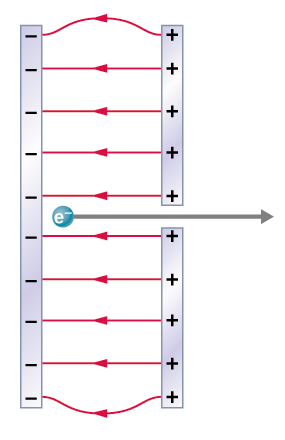
71. In a Geiger counter, a thin metallic wire at the center of a metallic tube is kept at a high voltage with respect to the metal tube. Ionizing radiation entering the tube knocks electrons off gas molecules or sides of the tube that then accelerate towards the center wire, knocking off even more electrons. This process eventually leads to an avalanche that is detectable as a current. A particular Geiger counter has a tube of radius R and the inner wire of radius a is at a potential of V0 volts with respect to the outer metal tube. Consider a point P at a distance s from the center wire and far away from the ends.
(a) Find a formula for the electric field at a point P inside using the infinite wire approximation.
(b) Find a formula for the electric potential at a point P inside.
(c) Use V0=900V,a=3.00mm,R=2.00cm, and find the value of the electric field at a point 1.00 cm from the center.
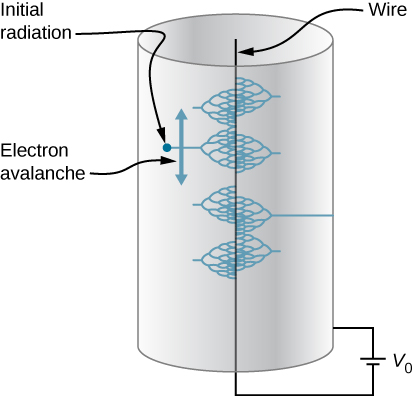
72. The practical limit to an electric field in air is about 3.00×106N/C. Above this strength, sparking takes place because air begins to ionize.
(a) At this electric field strength, how far would a proton travel before hitting the speed of light (ignore relativistic effects)?
(b) Is it practical to leave air in particle accelerators?
73. To form a helium atom, an alpha particle that contains two protons and two neutrons is fixed at one location, and two electrons are brought in from far away, one at a time. The first electron is placed at 0.600×10−10m from the alpha particle and held there while the second electron is brought to 0.600×10−10m from the alpha particle on the other side from the first electron. See the final configuration below.
(a) How much work is done in each step?
(b) What is the electrostatic energy of the alpha particle and two electrons in the final configuration?

74. Find the electrostatic energy of eight equal charges (+3µC) each fixed at the corners of a cube of side 2 cm.
75. The probability of fusion occurring is greatly enhanced when appropriate nuclei are brought close together, but mutual Coulomb repulsion must be overcome. This can be done using the kinetic energy of high-temperature gas ions or by accelerating the nuclei toward one another.
(a) Calculate the potential energy of two singly charged nuclei separated by 1.00×10−12m.
(b) At what temperature will atoms of a gas have an average kinetic energy equal to this needed electrical potential energy?
76. A bare helium nucleus has two positive charges and a mass of 6.64×10–27kg.
(a) Calculate its kinetic energy in joules at 2.00 of the speed of light.
(b) What is this in electron-volts?
(c) What voltage would be needed to obtain this energy?
77. An electron enters a region between two large parallel plates made of aluminum separated by a distance of 2.0 cm and kept at a potential difference of 200 V. The electron enters through a small hole in the negative plate and moves toward the positive plate. At the time the electron is near the negative plate, its speed is 4.0×105m/s. Assume the electric field between the plates to be uniform, and find the speed of electron at
(a) 0.10 cm,
(b) 0.50 cm,
(c) 1.0 cm, and
(d) 1.5 cm from the negative plate, and
(e) immediately before it hits the positive plate.

78. How far apart are two conducting plates that have an electric field strength of 4.50×103V/m between them, if their potential difference is 15.0 kV?
79. (a) Will the electric field strength between two parallel conducting plates exceed the breakdown strength of dry air, which is 3.00×106V/m, if the plates are separated by 2.00 mm and a potential difference of 5.0×103V is applied?
(b) How close together can the plates be with this applied voltage?
80. Membrane walls of living cells have surprisingly large electric fields across them due to separation of ions. What is the voltage across an 8.00-nm-thick membrane if the electric field strength across it is 5.50 MV/m? You may assume a uniform electric field.
81. A double charged ion is accelerated to an energy of 32.0 keV by the electric field between two parallel conducting plates separated by 2.00 cm. What is the electric field strength between the plates?
82. The temperature near the center of the Sun is thought to be 15 million degrees Celsius (1.5×107°C) (or kelvin). Through what voltage must a singly charged ion be accelerated to have the same energy as the average kinetic energy of ions at this temperature?
83. A lightning bolt strikes a tree, moving 20.0 C of charge through a potential difference of 1.00×102MV.
(a) What energy was dissipated?
(b) What mass of water could be raised from 15°C to the boiling point and then boiled by this energy?
(c) Discuss the damage that could be caused to the tree by the expansion of the boiling steam.
84. What is the potential 0.530×10−10m from a proton (the average distance between the proton and electron in a hydrogen atom)?
85. (a) A sphere has a surface uniformly charged with 1.00 C. At what distance from its center is the potential 5.00 MV? (b) What does your answer imply about the practical aspect of isolating such a large charge?
86. What are the sign and magnitude of a point charge that produces a potential of –2.00 V at a distance of 1.00 mm?
87. In one of the classic nuclear physics experiments at the beginning of the twentieth century, an alpha particle was accelerated toward a gold nucleus, and its path was substantially deflected by the Coulomb interaction. If the energy of the doubly charged alpha nucleus was 5.00 MeV, how close to the gold nucleus (79 protons) could it come before being deflected?
Additional Problems
88. A 12.0-V battery-operated bottle warmer heats 50.0 g of glass, 2.50×102g of baby formula, and 2.00×102g of aluminum from 20.0°C to 90.0°C.
(a) How much charge is moved by the battery?
(b) How many electrons per second flow if it takes 5.00 min to warm the formula? (Hint: Assume that the specific heat of baby formula is about the same as the specific heat of water.)
89. A battery-operated car uses a 12.0-V system. Find the charge the batteries must be able to move in order to accelerate the 750 kg car from rest to 25.0 m/s, make it climb a 2.00×102−m high hill, and finally cause it to travel at a constant 25.0 m/s while climbing with 5.00×102−N force for an hour.
90. (a) Find the voltage near a 10.0 cm diameter metal sphere that has 8.00 C of excess positive charge on it.
(b) What is unreasonable about this result?
(c) Which assumptions are responsible?
91. A uniformly charged half-ring of radius 10 cm is placed on a nonconducting table. It is found that 3.0 cm above the center of the half-ring the potential is –3.0 V with respect to zero potential at infinity. How much charge is in the half-ring?
92. A glass ring of radius 5.0 cm is painted with a charged paint such that the charge density around the ring varies continuously given by the following function of the polar angle θ,λ=(3.0×10−6C/m)cos2θ.. Find the potential at a point 15 cm above the center.
93. A CD disk of radius (R=3.0cm) is sprayed with a charged paint so that the charge varies continually with radial distance rfrom the center in the following manner: σ=−(6.0C/m)r/R. Find the potential at a point 4 cm above the center.
94. (a) What is the final speed of an electron accelerated from rest through a voltage of 25.0 MV by a negatively charged Van de Graff terminal? (b) What is unreasonable about this result? (c) Which assumptions are responsible?
95. A large metal plate is charged uniformly to a density of σ=2.0×10−9C/m2. How far apart are the equipotential surfaces that represent a potential difference of 25 V?
96. Your friend gets really excited by the idea of making a lightning rod or maybe just a sparking toy by connecting two spheres as shown in Figure 7.39, and making R2 so small that the electric field is greater than the dielectric strength of air, just from the usual 150 V/m electric field near the surface of the Earth. If R1 is 10 cm, how small does R2 need to be, and does this seem practical? (Hint: recall the calculation for electric field at the surface of a conductor from Gauss’s Law.)
97. (a) Find x>>L limit of the potential of a finite uniformly charged rod and show that it coincides with that of a point charge formula. (b) Why would you expect this result?
98. A small spherical pith ball of radius 0.50 cm is painted with a silver paint and then −10μC of charge is placed on it. The charged pith ball is put at the center of a gold spherical shell of inner radius 2.0 cm and outer radius 2.2 cm.
(a) Find the electric potential of the gold shell with respect to zero potential at infinity.
(b) How much charge should you put on the gold shell if you want to make its potential 100 V?
99. Two parallel conducting plates, each of cross-sectional area 400cm2, are 2.0 cm apart and uncharged. If 1.0×1012 electrons are transferred from one plate to the other,
(a) what is the potential difference between the plates?
(b) What is the potential difference between the positive plate and a point 1.25 cm from it that is between the plates?
100. A point charge of q=5.0×10−8C is placed at the center of an uncharged spherical conducting shell of inner radius 6.0 cm and outer radius 9.0 cm. Find the electric potential at
(a) r=4.0cm,
(b) r=8.0cm,
(c) r=12.0cm.
101. Earth has a net charge that produces an electric field of approximately 150 N/C downward at its surface.
(a) What is the magnitude and sign of the excess charge, noting the electric field of a conducting sphere is equivalent to a point charge at its center?
(b) What acceleration will the field produce on a free electron near Earth’s surface?
(c) What mass object with a single extra electron will have its weight supported by this field?
102. Point charges of 25.0μC and 45.0μC are placed 0.500 m apart.
(a) At what point along the line between them is the electric field zero?
(b) What is the electric field halfway between them?
103. What can you say about two charges q1 and q2, if the electric field one-fourth of the way from q1 to q2 is zero?
104. Calculate the angular velocity ω of an electron orbiting a proton in the hydrogen atom, given the radius of the orbit is 0.530×10−10m. You may assume that the proton is stationary and the centripetal force is supplied by Coulomb attraction.
105. An electron has an initial velocity of 5.00×106m/s in a uniform 2.00×105−N/C electric field. The field accelerates the electron in the direction opposite to its initial velocity.
(a) What is the direction of the electric field?
(b) How far does the electron travel before coming to rest?
(c) How long does it take the electron to come to rest?
(d) What is the electron’s velocity when it returns to its starting point?
Challenge Problems
106. Three Na+ and three Cl− ions are placed alternately and equally spaced around a circle of radius 50 nm. Find the electrostatic energy stored.
107. Look up (presumably online, or by dismantling an old device and making measurements) the magnitude of the potential deflection plates (and the space between them) in an ink jet printer. Then look up the speed with which the ink comes out the nozzle. Can you calculate the typical mass of an ink drop?
108. Use the electric field of a finite sphere with constant volume charge density to calculate the electric potential, throughout space. Then check your results by calculating the electric field from the potential.
109. Calculate the electric field of a dipole throughout space from the potential.
Contributors and Attributions
Samuel J. Ling (Truman State University), Jeff Sanny (Loyola Marymount University), and Bill Moebs with many contributing authors. This work is licensed by OpenStax University Physics under a Creative Commons Attribution License (by 4.0).
Capacitors and Capacitance Practice
Conceptual Questions
Capacitors and Capacitance
1. Does the capacitance of a device depend on the applied voltage? Does the capacitance of a device depend on the charge residing on it?
2. Would you place the plates of a parallel-plate capacitor closer together or farther apart to increase their capacitance?
3. The value of the capacitance is zero if the plates are not charged. True or false?
4. If the plates of a capacitor have different areas, will they acquire the same charge when the capacitor is connected across a battery?
5. Does the capacitance of a spherical capacitor depend on which sphere is charged positively or negatively?
Capacitors in Series and in Parallel
6. If you wish to store a large amount of charge in a capacitor bank, would you connect capacitors in series or in parallel? Explain.
7. What is the maximum capacitance you can get by connecting three 1.0-μF capacitors? What is the minimum capacitance?
Energy Stored in a Capacitor
8. If you wish to store a large amount of energy in a capacitor bank, would you connect capacitors in series or parallel? Explain.
Capacitor with a Dielectric
9. Discuss what would happen if a conducting slab rather than a dielectric were inserted into the gap between the capacitor plates.
10. Discuss how the energy stored in an empty but charged capacitor changes when a dielectric is inserted if (a) the capacitor is isolated so that its charge does not change; (b) the capacitor remains connected to a battery so that the potential difference between its plates does not change.
Molecular Model of a Dielectric
11. Distinguish between dielectric strength and dielectric constant.
12. Water is a good solvent because it has a high dielectric constant. Explain.
13. Water has a high dielectric constant. Explain why it is then not used as a dielectric material in capacitors.
14. Elaborate on why molecules in a dielectric material experience net forces on them in a non-uniform electrical field but not in a uniform field.
15. Explain why the dielectric constant of a substance containing permanent molecular electric dipoles decreases with increasing temperature.
16. Give a reason why a dielectric material increases capacitance compared with what it would be with air between the plates of a capacitor. How does a dielectric material also allow a greater voltage to be applied to a capacitor? (The dielectric thus increases C and permits a greater V.)
17. Elaborate on the way in which the polar character of water molecules helps to explain water’s relatively large dielectric constant.
18. Sparks will occur between the plates of an air-filled capacitor at a lower voltage when the air is humid than when it is dry. Discuss why, considering the polar character of water molecules.
Problems
Capacitors and Capacitance
19. What charge is stored in a 180.0-μF capacitor when 120.0 V is applied to it?
20. Find the charge stored when 5.50 V is applied to an 8.00-pF capacitor.
21. Calculate the voltage applied to a 2.00-μF capacitor when it holds 3.10μC of charge.
22. What voltage must be applied to an 8.00-nF capacitor to store 0.160 mC of charge?
23. What capacitance is needed to store 3.00μC of charge at a voltage of 120 V?
24. What is the capacitance of a large Van de Graaff generator’s terminal, given that it stores 8.00 mC of charge at a voltage of 12.0 MV?
25. The plates of an empty parallel-plate capacitor of capacitance 5.0 pF are 2.0 mm apart. What is the area of each plate?
26. A 60.0-pF vacuum capacitor has a plate area of 0.010m2. What is the separation between its plates?
27. A set of parallel plates has a capacitance of 5.0µF. How much charge must be added to the plates to increase the potential difference between them by 100 V?
28. Consider Earth to be a spherical conductor of radius 6400 km and calculate its capacitance.
29. If the capacitance per unit length of a cylindrical capacitor is 20 pF/m, what is the ratio of the radii of the two cylinders?
30. An empty parallel-plate capacitor has a capacitance of 20µF. How much charge must leak off its plates before the voltage across them is reduced by 100 V?
Capacitors in Series and in Parallel
31. A 4.00-pF is connected in series with an 8.00-pF capacitor and a 400-V potential difference is applied across the pair. (a) What is the charge on each capacitor?
(b) What is the voltage across each capacitor?
32. Three capacitors, with capacitances of C1=2.0μF,C2=3.0μF, and C3=6.0μF, respectively, are connected in parallel. A 500-V potential difference is applied across the combination. Determine the voltage across each capacitor and the charge on each capacitor.
33. Find the total capacitance of this combination of series and parallel capacitors shown below.
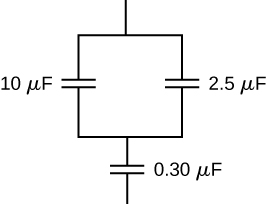
34. Suppose you need a capacitor bank with a total capacitance of 0.750 F but you have only 1.50-mF capacitors at your disposal. What is the smallest number of capacitors you could connect together to achieve your goal, and how would you connect them?
35. What total capacitances can you make by connecting a 5.00-μF and a 8.00-μF capacitor?
36. Find the equivalent capacitance of the combination of series and parallel capacitors shown below.
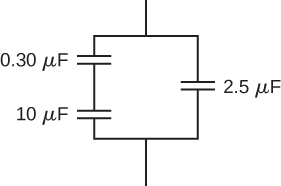
37. Find the net capacitance of the combination of series and parallel capacitors shown below.
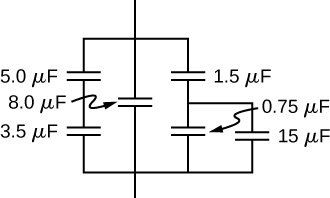
38. A 40-pF capacitor is charged to a potential difference of 500 V. Its terminals are then connected to those of an uncharged 10-pF capacitor. Calculate:
(a) the original charge on the 40-pF capacitor;
(b) the charge on each capacitor after the connection is made; and
(c) the potential difference across the plates of each capacitor after the connection.
39. A 2.0-μF capacitor and a 4.0-μF capacitor are connected in series across a 1.0-kV potential. The charged capacitors are then disconnected from the source and connected to each other with terminals of like sign together. Find the charge on each capacitor and the voltage across each capacitor.
Energy Stored in a Capacitor
40. How much energy is stored in an 8.00-μF capacitor whose plates are at a potential difference of 6.00 V?
41. A capacitor has a charge of 2.5μC when connected to a 6.0-V battery. How much energy is stored in this capacitor?
42. How much energy is stored in the electrical field of a metal sphere of radius 2.0 m that is kept at a 10.0-V potential?
43. (a) What is the energy stored in the 10.0-μF capacitor of a heart defibrillator charged to 9.00×103V?
(b) Find the amount of the stored charge.
44. In open-heart surgery, a much smaller amount of energy will defibrillate the heart.
(a) What voltage is applied to the 8.00-μF capacitor of a heart defibrillator that stores 40.0 J of energy?
(b) Find the amount of the stored charge.
45. A 165-μF capacitor is used in conjunction with a dc motor. How much energy is stored in it when 119 V is applied?
46. Suppose you have a 9.00-V battery, a 2.00-μF capacitor, and a 7.40-μF capacitor.
(a) Find the charge and energy stored if the capacitors are connected to the battery in series.
(b) Do the same for a parallel connection.
47. An anxious physicist worries that the two metal shelves of a wood frame bookcase might obtain a high voltage if charged by static electricity, perhaps produced by friction.
(a) What is the capacitance of the empty shelves if they have area 1.00×102m and are 0.200 m apart?
(b) What is the voltage between them if opposite charges of magnitude 2.00 nC are placed on them?
(c) To show that this voltage poses a small hazard, calculate the energy stored.
(d) The actual shelves have an area 100 times smaller than these hypothetical shelves. Are his fears justified?
48. A parallel-plate capacitor is made of two square plates 25 cm on a side and 1.0 mm apart. The capacitor is connected to a 50.0-V battery. With the battery still connected, the plates are pulled apart to a separation of 2.00 mm. What are the energies stored in the capacitor before and after the plates are pulled farther apart? Why does the energy decrease even though work is done in separating the plates?
49. Suppose that the capacitance of a variable capacitor can be manually changed from 100 pF to 800 pF by turning a dial, connected to one set of plates by a shaft, from 0° to 180°. With the dial set at 180°180° (corresponding to C=800pF), the capacitor is connected to a 500-V source. After charging, the capacitor is disconnected from the source, and the dial is turned to 0°. If friction is negligible, how much work is required to turn the dial from 180° to 0°?
Capacitor with a Dielectric
50. Show that for a given dielectric material, the maximum energy a parallel-plate capacitor can store is directly proportional to the volume of dielectric.
51. An air-filled capacitor is made from two flat parallel plates 1.0 mm apart. The inside area of each plate is 8.0cm28.0cm2.
(a) What is the capacitance of this set of plates?
(b) If the region between the plates is filled with a material whose dielectric constant is 6.0, what is the new capacitance?
52. A capacitor is made from two concentric spheres, one with radius 5.00 cm, the other with radius 8.00 cm.
(a) What is the capacitance of this set of conductors?
(b) If the region between the conductors is filled with a material whose dielectric constant is 6.00, what is the capacitance of the system?
53. A parallel-plate capacitor has charge of magnitude 9.00μC on each plate and capacitance 3.00μF when there is air between the plates. The plates are separated by 2.00 mm. With the charge on the plates kept constant, a dielectric with κ=5 is inserted between the plates, completely filling the volume between the plates.
(a) What is the potential difference between the plates of the capacitor, before and after the dielectric has been inserted?
(b) What is the electrical field at the point midway between the plates before and after the dielectric is inserted?
54. Some cell walls in the human body have a layer of negative charge on the inside surface. Suppose that the surface charge densities are ±0.50×10−3C/m2, the cell wall is 5.0×10−9m thick, and the cell wall material has a dielectric constant of κ=5.4.
(a) Find the magnitude of the electric field in the wall between two charge layers.
(b) Find the potential difference between the inside and the outside of the cell. Which is at higher potential?
(c) A typical cell in the human body has volume 10−16m3. Estimate the total electrical field energy stored in the wall of a cell of this size when assuming that the cell is spherical. (Hint: Calculate the volume of the cell wall.)
55. A parallel-plate capacitor with only air between its plates is charged by connecting the capacitor to a battery. The capacitor is then disconnected from the battery, without any of the charge leaving the plates.
(a) A voltmeter reads 45.0 V when placed across the capacitor. When a dielectric is inserted between the plates, completely filling the space, the voltmeter reads 11.5 V. What is the dielectric constant of the material?
(b) What will the voltmeter read if the dielectric is now pulled away out so it fills only one-third of the space between the plates?
Molecular Model of a Dielectric
56. Two flat plates containing equal and opposite charges are separated by material 4.0 mm thick with a dielectric constant of 5.0. If the electrical field in the dielectric is 1.5 MV/m, what are
(a) the charge density on the capacitor plates, and
(b) the induced charge density on the surfaces of the dielectric?
57. For a Teflon™-filled, parallel-plate capacitor, the area of the plate is 50.0cm2 and the spacing between the plates is 0.50 mm. If the capacitor is connected to a 200-V battery, find
(a) the free charge on the capacitor plates,
(b) the electrical field in the dielectric, and
(c) the induced charge on the dielectric surfaces.
58. Find the capacitance of a parallel-plate capacitor having plates with a surface area of 5.00m2 and separated by 0.100 mm of Teflon™.
59. (a) What is the capacitance of a parallel-plate capacitor with plates of area 1.50m2 that are separated by 0.0200 mm of neoprene rubber?
(b) What charge does it hold when 9.00 V is applied to it?
60. Two parallel plates have equal and opposite charges. When the space between the plates is evacuated, the electrical field is E=3.20×105V/m. When the space is filled with dielectric, the electrical field is E=2.50×105V/m.
(a) What is the surface charge density on each surface of the dielectric?
(b) What is the dielectric constant?
61. The dielectric to be used in a parallel-plate capacitor has a dielectric constant of 3.60 and a dielectric strength of 1.60×107V/m. The capacitor has to have a capacitance of 1.25 nF and must be able to withstand a maximum potential difference 5.5 kV. What is the minimum area the plates of the capacitor may have?
62. When a 360-nF air capacitor is connected to a power supply, the energy stored in the capacitor is 18.5μJ. While the capacitor is connected to the power supply, a slab of dielectric is inserted that completely fills the space between the plates. This increases the stored energy by 23.2μJ.
(a) What is the potential difference between the capacitor plates?
(b) What is the dielectric constant of the slab?
63. A parallel-plate capacitor has square plates that are 8.00 cm on each side and 3.80 mm apart. The space between the plates is completely filled with two square slabs of dielectric, each 8.00 cm on a side and 1.90 mm thick. One slab is Pyrex glass and the other slab is polystyrene. If the potential difference between the plates is 86.0 V, find how much electrical energy can be stored in this capacitor.
Additional Problems
64. A capacitor is made from two flat parallel plates placed 0.40 mm apart. When a charge of 0.020μC is placed on the plates the potential difference between them is 250 V.
(a) What is the capacitance of the plates?
(b) What is the area of each plate?
(c) What is the charge on the plates when the potential difference between them is 500 V?
(d) What maximum potential difference can be applied between the plates so that the magnitude of electrical fields between the plates does not exceed 3.0 MV/m?
65. An air-filled (empty) parallel-plate capacitor is made from two square plates that are 25 cm on each side and 1.0 mm apart. The capacitor is connected to a 50-V battery and fully charged. It is then disconnected from the battery and its plates are pulled apart to a separation of 2.00 mm.
(a) What is the capacitance of this new capacitor?
(b) What is the charge on each plate?
(c) What is the electrical field between the plates?
66. Suppose that the capacitance of a variable capacitor can be manually changed from 100 to 800 pF by turning a dial connected to one set of plates by a shaft, from 0° to 180°. With the dial set at 180° (corresponding to C=800pF), the capacitor is connected to a 500-V source. After charging, the capacitor is disconnected from the source, and the dial is turned to 0°. (a) What is the charge on the capacitor? (b) What is the voltage across the capacitor when the dial is set to 0°?
67. Earth can be considered as a spherical capacitor with two plates, where the negative plate is the surface of Earth and the positive plate is the bottom of the ionosphere, which is located at an altitude of approximately 70 km. The potential difference between Earth’s surface and the ionosphere is about 350,000 V.
(a) Calculate the capacitance of this system.
(b) Find the total charge on this capacitor.
(c) Find the energy stored in this system.
68. A 4.00-μF capacitor and a 6.00-μF capacitor are connected in parallel across a 600-V supply line.
(a) Find the charge on each capacitor and voltage across each.
(b) The charged capacitors are disconnected from the line and from each other. They are then reconnected to each other with terminals of unlike sign together. Find the final charge on each capacitor and the voltage across each.
69. Three capacitors having capacitances of 8.40, 8.40, and 4.20 μF, respectively, are connected in series across a 36.0-V potential difference.
(a) What is the charge on the 4.20-μF capacitor?
(b) The capacitors are disconnected from the potential difference without allowing them to discharge. They are then reconnected in parallel with each other with the positively charged plates connected together. What is the voltage across each capacitor in the parallel combination?
70. A parallel-plate capacitor with capacitance 5.0μF is charged with a 12.0-V battery, after which the battery is disconnected. Determine the minimum work required to increase the separation between the plates by a factor of 3.
71. (a) How much energy is stored in the electrical fields in the capacitors (in total) shown below?
(b) Is this energy equal to the work done by the 400-V source in charging the capacitors?
72. Three capacitors having capacitances 8.4, 8.4, and 4.2 μF are connected in series across a 36.0-V potential difference.
(a) What is the total energy stored in all three capacitors?
(b) The capacitors are disconnected from the potential difference without allowing them to discharge. They are then reconnected in parallel with each other with the positively charged plates connected together. What is the total energy now stored in the capacitors?
73. (a) An 8.00-μF capacitor is connected in parallel to another capacitor, producing a total capacitance of 5.00μF. What is the capacitance of the second capacitor?
(b) What is unreasonable about this result?
(c) Which assumptions are unreasonable or inconsistent?
74. (a) On a particular day, it takes 9.60×103J of electrical energy to start a truck’s engine. Calculate the capacitance of a capacitor that could store that amount of energy at 12.0 V.
(b) What is unreasonable about this result?
(c) Which assumptions are responsible?
75. (a) A certain parallel-plate capacitor has plates of area 4.00m2, separated by 0.0100 mm of nylon, and stores 0.170 C of charge. What is the applied voltage?
(b) What is unreasonable about this result?
(c) Which assumptions are responsible or inconsistent?
76. A prankster applies 450 V to an 80.0-μF capacitor and then tosses it to an unsuspecting victim. The victim’s finger is burned by the discharge of the capacitor through 0.200 g of flesh. Estimate, what is the temperature increase of the flesh? Is it reasonable to assume that no thermodynamic phase change happened?
Challenge Problems
77. A spherical capacitor is formed from two concentric spherical conducting spheres separated by vacuum. The inner sphere has radius 12.5 cm and the outer sphere has radius 14.8 cm. A potential difference of 120 V is applied to the capacitor.
(a) What is the capacitance of the capacitor?
(b) What is the magnitude of the electrical field at r=12.6cm, just outside the inner sphere?
(c) What is the magnitude of the electrical field at r=14.7cm, just inside the outer sphere?
(d) For a parallel-plate capacitor the electrical field is uniform in the region between the plates, except near the edges of the plates. Is this also true for a spherical capacitor?
78. The network of capacitors shown below are all uncharged when a 300-V potential is applied between points A and B with the switch S open.
(a) What is the potential difference VE−VD?
(b) What is the potential at point E after the switch is closed?
(c) How much charge flows through the switch after it is closed?

79. Electronic flash units for cameras contain a capacitor for storing the energy used to produce the flash. In one such unit the flash lasts for 1/675 fraction of a second with an average light power output of 270 kW.
(a) If the conversion of electrical energy to light is 95% efficient (because the rest of the energy goes to thermal energy), how much energy must be stored in the capacitor for one flash?
(b) The capacitor has a potential difference between its plates of 125 V when the stored energy equals the value stored in part (a). What is the capacitance?
80. A spherical capacitor is formed from two concentric spherical conducting shells separated by a vacuum. The inner sphere has radius 12.5 cm and the outer sphere has radius 14.8 cm. A potential difference of 120 V is applied to the capacitor.
(a) What is the energy density at r=12.6cm, just outside the inner sphere?
(b) What is the energy density at r=14.7cm, just inside the outer sphere?
(c) For the parallel-plate capacitor the energy density is uniform in the region between the plates, except near the edges of the plates. Is this also true for the spherical capacitor?
81. A metal plate of thickness t is held in place between two capacitor plates by plastic pegs, as shown below. The effect of the pegs on the capacitance is negligible. The area of each capacitor plate and the area of the top and bottom surfaces of the inserted plate are all A. What is the capacitance of this system?
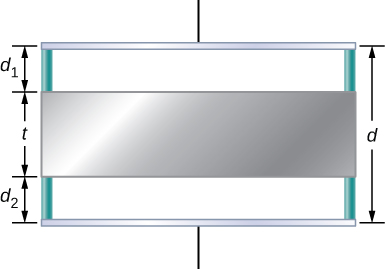
82. A parallel-plate capacitor is filled with two dielectrics, as shown below. When the plate area is A and separation between plates is d, show that the capacitance is given by C=ε0Adκ1+κ22.
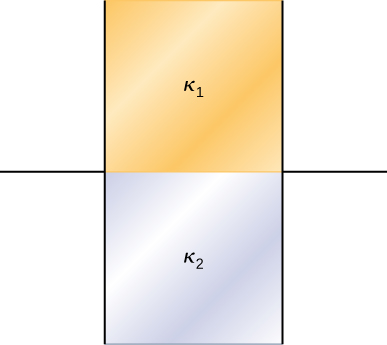
83. A parallel-plate capacitor is filled with two dielectrics, as shown below. Show that the capacitance is given by C=2ε0Adκ1κ2κ1+κ2.

84. A capacitor has parallel plates of area 12cm2 separated by 2.0 mm. The space between the plates is filled with polystyrene.
(a) Find the maximum permissible voltage across the capacitor to avoid dielectric breakdown.
(b) When the voltage equals the value found in part (a), find the surface charge density on the surface of the dielectric.
Contributors and Attributions
Samuel J. Ling (Truman State University), Jeff Sanny (Loyola Marymount University), and Bill Moebs with many contributing authors. This work is licensed by OpenStax University Physics under a Creative Commons Attribution License (by 4.0).
Practice Answers
Check Your Understanding
1. K=12mv2,v=√2Km=√24.5×10−7J4.00×10−9kg=15m/s
2. It has kinetic energy of 4.5×10−7J at point r2 and potential energy of 9.0×10−7JJ, which means that as Q approaches infinity, its kinetic energy totals three times the kinetic energy at r2, since all of the potential energy gets converted to kinetic.
3. positive, negative, and these quantities are the same as the work you would need to do to bring the charges in from infinity
4. ΔU=qΔV=(100C)(1.5V)=150J
5. –2.00 C, ne=1.25×1019electronsne
6. It would be going in the opposite direction, with no effect on the calculations as presented.
7. Given a fixed maximum electric field strength, the potential at which a strike occurs increases with increasing height above the ground. Hence, each electron will carry more energy. Determining if there is an effect on the total number of electrons lies in the future.
8. V=kqr=(8.99×109N⋅m2/C2)(−3.00×10−9C5.00×10−3m)=−5390V; recall that the electric field inside a conductor is zero. Hence, any path from a point on the surface to any point in the interior will have an integrand of zero when calculating the change in potential, and thus the potential in the interior of the sphere is identical to that on the surface.
9. The x-axis the potential is zero, due to the equal and opposite charges the same distance from it. On the z-axis, we may superimpose the two potentials; we will find that for z>>d, again the potential goes to zero due to cancellation.
10. It will be zero, as at all points on the axis, there are equal and opposite charges equidistant from the point of interest. Note that this distribution will, in fact, have a dipole moment.
11. Any, but cylindrical is closest to the symmetry of a dipole.
12. infinite cylinders of constant radius, with the line charge as the axis
Conceptual Questions
1. No. We can only define potential energies for conservative fields.
3. No, though certain orderings may be simpler to compute.
5. The electric field strength is zero because electric potential differences are directly related to the field strength. If the potential difference is zero, then the field strength must also be zero.
7. Potential difference is more descriptive because it indicates that it is the difference between the electric potential of two points.
9. They are very similar, but potential difference is a feature of the system; when a charge is introduced to the system, it will have a potential energy which may be calculated by multiplying the magnitude of the charge by the potential difference.
11. An electron-volt is a volt multiplied by the charge of an electron. Volts measure potential difference, electron-volts are a unit of energy.
13. The second has 1/4 the dipole moment of the first.
15. The region outside of the sphere will have a potential indistinguishable from a point charge; the interior of the sphere will have a different potential.
17. No. It will be constant, but not necessarily zero.
19. no
21. No; it might not be at electrostatic equilibrium.
23. Yes. It depends on where the zero reference for potential is. (Though this might be unusual.)
25. So that lightning striking them goes into the ground instead of the television equipment.
27. They both make use of static electricity to stick small particles to another surface. However, the precipitator has to charge a wide variety of particles, and is not designed to make sure they land in a particular place.
Problems
29. a. U=3.4J;
b. 12mv2=kQ1Q2(1ri−1rf)→v=750m/s
31. U=4.36×10−18J
33. 12mev2e=qV,12mHv2H=qV,so that mev2emHv2H=1 or vevH=42.8.
35. 1V=1J/C;1J=1N⋅m→1V/m=1N/C
37. a. VAB=3.00kV;
b. VAB=7.50kV
39. a. VAB=Ed→E=5.63kV/m;
b. VAB=563V
41. a. ΔK=qΔV and VAB=Ed,so that ΔK=800keV;
b. d=25.0km
43. One possibility is to stay at constant radius and go along the arc from P1 to P2, which will have zero potential due to the path being perpendicular to the electric field. Then integrate from a to b: Vab=αln(ba)
45. V=144V
47. V=kQr→Q=8.33×10−7C; The charge is positive because the potential is positive.
49. a. V=45.0MV;
b. V=kQr→r=45.0m;
c. ΔU=132MeV
51. V=kQ/r; a. Relative to origin, find the potential at each point and then calculate the difference. ΔV=135×103V;
b. To double the potential difference, move the point from 20 cm to infinity; the potential at 20 cm is halfway between zero and that at 10 cm.
53. a. VP1=7.4×105V and VP2=6.9×103V;
b. VP1=6.9×105V and VP2=6.9×103V
55. The problem is describing a uniform field, so E=200V/m in the –z-direction.
57. Apply vecE=−→∇V with →∇=ˆr∂∂r+ˆφ1r∂∂φ+ˆz∂∂z to the potential calculated earlier, V=−2kλlns:→E=2kλ1rˆr as expected.
59. a. increases; the constant (negative) electric field has this effect, the reference point only matters for magnitude; b. they are planes parallel to the sheet; c. 0.006 m
61. a. from the previous chapter, the electric field has magnitude σε0 in the region between the plates and zero outside; defining the negatively charged plate to be at the origin and zero potential, with the positively charged plate located at +5mm in the z-direction, V=1.7×104VV=1.7×104Vso the potential is 0 for z<0,1.7×104V(z5mm) for 0≤z≤5mm,1.7×104V for z>5mm;
b. qV=12mv2→v=7.7×107m/s
63. V=85V
65. In the region a≤r≤b,→E=kQr2ˆr, and E is zero elsewhere; hence, the potential difference is V=kQ(1a−1b).
67. From previous results VP−VR=−2kλlnsPsR., note that b is a very convenient location to define the zero level of potential: ΔV=−2kQLlnab.
69. a. F=5.58×10−11N/C;The electric field is towards the surface of Earth.
b. The coulomb force is much stronger than gravity.
71. We know from the Gauss’s law chapter that the electric field for an infinite line charge is →EP=2kλ1sˆs, and from earlier in this chapter that the potential of a wire-cylinder system of this sort is VP=−2kλlnsPR by integration. We are not given λ, but we are given a fixed V0; thus, we know that V0=−2kλlnaR and hence λ=−V02kln(aR). We may substitute this back in to find a. →EP=−V0ln(aR)1sˆs;
b. VP=V0ln(sPR)ln(aR);
c. 4.74×104N/C
73. a. U1=7.68×10−18J,U2=5.76×10−18J;
b. U1+U2=−1.34×10−17J
75. a. \(\displaystyle U=2.30×10^{−16}J;
b. ¯K=32kT→T=1.11×107
77. a. 1.9×106m/s;
b. 4.2×106m/s;
c. 5.9×106m/s;
d. 7.3×106m/s;
e. 8.4×106m/s
79. a. E=2.5×106V/m<3×106V/m No, the field strength is smaller than the breakdown strength for air.
b. d=1.7mm
81. Kf=qVAB=qEd→E=8.00×105V/m
83. a. Energy=2.00×109J;
b. Q=m(cΔT+L∇) m=766kg;
c. The expansion of the steam upon boiling can literally blow the tree apart.
85. a. V=kQr→r=1.80km;
b. A 1-C charge is a very large amount of charge; a sphere of 1.80 km is impractical.
87. The alpha particle approaches the gold nucleus until its original energy is converted to potential energy. 5.00MeV=8.00×10−13J, so E0=qkQr→r=4.54×10−14m
(Size of gold nucleus is about 7×10−15m).
Additional Problems
89. Etot=4.67×107J Etot=qV→q=EtotV=3.89×106C
91. VP=kqtot√z2+R2→qtot=−3.5×10−11C
93. VP=−2.2GV
95. Recall from the previous chapter that the electric field EP=σ02ε0 is uniform throughout space, and that for uniform fields we have E=−ΔVΔz for the relation. Thus, we get σ2ε0=ΔVΔz→Δz=0.22m for the distance between 25-V equipotentials.
97. a. Take the result from Example 7.13, divide both the numerator and the denominator by x, take the limit of that, and then apply a Taylor expansion to the resulting log to get: VP≈kλLx;
b. which is the result we expect, because at great distances, this should look like a point charge of q=λL
99. a. V=9.0×103V;
b. −9.0×103V(1.25cm2.0cm)=−5.7×103V
101. a. E=KQr2→Q=−6.76×105C;
b. F=ma=qE→a=qEm=2.63×1013m/s2(upwards);
c. F=−mg=qE→m=−qEg=2.45×10−18kg
103. If the electric field is zero ¼ from the way of q1 and q2, then we know from E=kQr2 that |E1|=|E2|→Kq1x2=Kq2(3x)2 so that q2q1=(3x)2x2=9; the charge q2 is 9 times larger than q1.
105. a. The field is in the direction of the electron’s initial velocity.
b. v2=v20+2ax→x=−v202a(v=0). Also, F=ma=qE→a=qEm,x=3.56×10−4m;
c. \displaystyle v_2=v_0+at→t=−\frac{v_0m}{qE}(v=0), ∴t=1.42×10^{−10}s;
d. \displaystyle v=−(\frac{2qEx}{m})^{1/2}−5.00×10^6m/s (opposite its initial velocity)
Challenge Problems
107. Answers will vary. This appears to be proprietary information, and ridiculously difficult to find. Speeds will be 20 m/s or less, and there are claims of \displaystyle ~10^{−7} grams for the mass of a drop.
109. Apply \displaystyle \vec{E}=−\vec{∇}V with \displaystyle \vec{∇}=\hat{r}\frac{∂}{∂r}+\hat{θ}\frac{1}{r}\frac{∂}{∂θ}+\hat{φ}\frac{1}{rsinθ}\frac{∂}{∂φ} to the potential calculated earlier, \displaystyle V_P=k\frac{\vec{p}⋅\hat{r}}{r^2} with \displaystyle \vec{p}=q\vec{d}, and assume that the axis of the dipole is aligned with the z-axis of the coordinate system. Thus, the potential is \displaystyle V_P=k\frac{q\vec{d}⋅\hat{r}}{r^2}=k\frac{qdcosθ}{r^2}.
\displaystyle \vec{E}=2kqd(\frac{cosθ}{r^3})\hat{r}+kqd(\frac{sinθ}{r^3})\hat{θ}
Contributors and Attributions
Samuel J. Ling (Truman State University), Jeff Sanny (Loyola Marymount University), and Bill Moebs with many contributing authors. This work is licensed by OpenStax University Physics under a Creative Commons Attribution License (by 4.0).
Check Your Understanding
1. \displaystyle 1.1×10^{−3}m
3. 3.59 cm, 17.98 cm
4. a. 25.0 pF;
b. 9.2
5. a. \displaystyle C=0.86pF,Q_1=10pC,Q_2=3.4pC,Q_3=6.8pC;
b. \displaystyle C=2.3pF,Q_1=12pC,Q_2=Q_3=16pC;
c. \displaystyle C=2.3pF,Q_1=9.0pC,Q_2=18pC,Q_3=12pC,Q_4=15pC
6. a.\displaystyle 4.0×10^{−13}J; b. 9 times
7. a. 3.0; b. \displaystyle C=3.0C_0
9. a. \displaystyle C_0=20pF, C=42pF;
b. \displaystyle Q_0=0.8nC, Q=1.7nC;
c. \displaystyle V_0=V=40V; d. \displaystyle U_0=16nJ, U=34nJ
Conceptual Questions
1. no; yes
3. false
5. no
7. \displaystyle 3.0μF,0.33μF
9. answers may vary
11. Dielectric strength is a critical value of an electrical field above which an insulator starts to conduct; a dielectric constant is the ratio of the electrical field in vacuum to the net electrical field in a material.
13. Water is a good solvent.
15. When energy of thermal motion is large (high temperature), an electrical field must be large too in order to keep electric dipoles aligned with it.
17. answers may vary
Problems
19. 21.6 mC
21. 1.55 V
23. 25.0 nF
25. \displaystyle 1.1×10^{−3}m^2
27. 500 µC
29. 1:16
31. a. 1.07 nC;
b. 267 V, 133 V
33. \displaystyle 0.29μF
34. 500 capacitors; connected in parallel
35. \displaystyle 3.08μF (series) and \displaystyle 13.0μ (parallel)
37. \displaystyle 11.4μF
39. 0.89 mC; 1.78 mC; 444 V
41. \displaystyle 7.5μJ
43. a. 405 J; b. 90.0 mC
45. 1.15 J
47. a. \displaystyle 4.43×10^{−9}F;
b. 0.453 V;
c. \displaystyle 4.53×10^{−10}J;
d. no
49. 0.7 mJ
51. a. 7.1 pF;
b. 42 pF
53. a. before 3.00 V; after 0.600 V;
b. before 1500 V/m; after 300 V/m
55. a. 3.91;
b. 22.8 V
57. a. 37 nC;
b. 0.4 MV/m;
c. 19 nC
59. a. \displaystyle 4.4μF;
b. \displaystyle 4.0×10^{-5}C
61. \displaystyle 0.0135m^2
63. \displaystyle 0.185μJ
Additional Problems
65. a. 0.277 nF;
b. 27.7 nC;
c. 50 kV/m
67. a. 0.065 F;
b. 23,000 C;
c. 4.0 GJ
69. a. \displaystyle 75.6μC; b. 10.8 V
71. a. 0.13 J;
b. no, because of resistive heating in connecting wires that is always present, but the circuit schematic does not indicate resistors
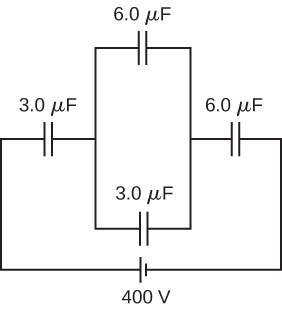
73. a. \displaystyle −3.00μF;
b. You cannot have a negative \displaystyle C_2 capacitance.
c. The assumption that they were hooked up in parallel, rather than in series, is incorrect. A parallel connection always produces a greater capacitance, while here a smaller capacitance was assumed. This could only happen if the capacitors are connected in series.
75. a. 14.2 kV;
b. The voltage is unreasonably large, more than 100 times the breakdown voltage of nylon.
c. The assumed charge is unreasonably large and cannot be stored in a capacitor of these dimensions.
Challenge Problems
77. a. 89.6 pF;
b. 6.09 kV/m;
c. 4.47 kV/m;
d. no
79. a. 421 J;
b. 53.9 mF
81. \displaystyle C=ε_0A/(d_1+d_2)
83. proof
Contributors and Attributions
Samuel J. Ling (Truman State University), Jeff Sanny (Loyola Marymount University), and Bill Moebs with many contributing authors. This work is licensed by OpenStax University Physics under a Creative Commons Attribution License (by 4.0).


